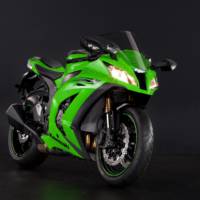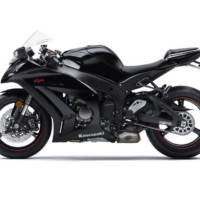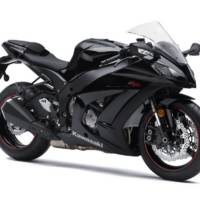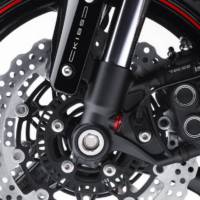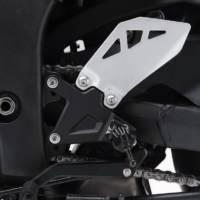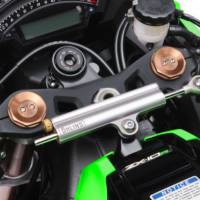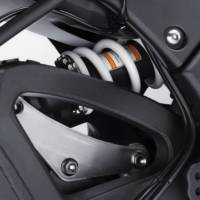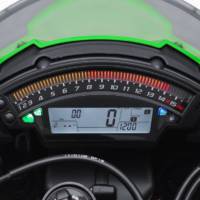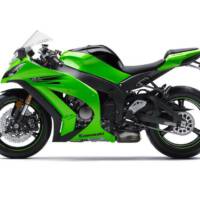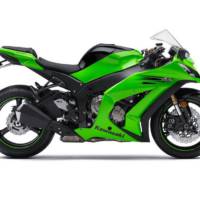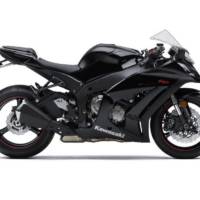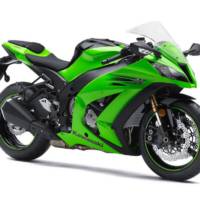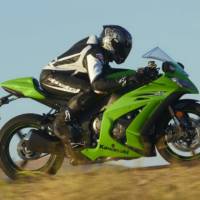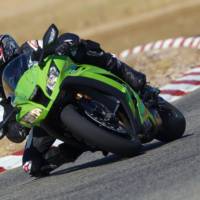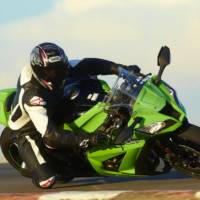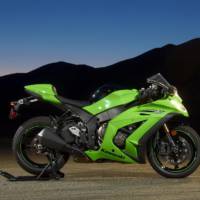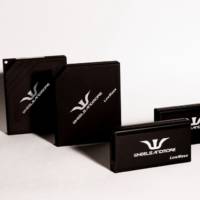The Japanese company has released photos and details with the new 2011 Kawasaki Ninja ZX-10R.
If compared to the previous generation, the 2011 Kawasaki Ninja ZX-10R is lighter, as it weights 436 lbs, and packs more power. To give you the actual figure, the 998cc, 16-valve, DOHC, liquid-cooled inline-four engine fitted on the 2011 Kawasaki Ninja ZX-10R develops an impressive 197 HP (or 207 with ram air in full effect).
These figures are pretty much taking the crown away from the BMW S 1000 RR, and that is not all, as the 2011 Kawasaki Ninja ZX-10R comes with the new KIRB system which is Kawasaki’s Intelligent anti-lock Brake System plus the new S-KTRC which minimizes wheel slip on slick or broken surfaces.
This S-KTRC TRaction Control system is offered as standard version 2011 Kawasaki Ninja ZX-10R, while the KIBS is an additional 1,000 USD.
The 2011 Kawasaki Ninja ZX-10R price is 13,799 USD.
Kawasaki press release :
The 2011 Kawasaki Ninja ZX-10R ABS: World’s Ultimate Sporting Motorcycle
It’s hard to imagine a more advanced or more capable sportbike than the completely new and totally redesigned Kawasaki Ninja® ZX™-10R. After all, it packs the very latest in sport bike technology, much of it right off the MotoGP circuit, including the most advanced traction-control system in production bike history.
But the ZX-10R has an even smarter sibling – the 2011 Ninja ZX-10R ABS.
At first glance, anti-lock braking might seem a touch out of place on a purebred sportbike. This system was designed from the start to provide maximum on-track performance. And when you consider the many safety- and control-oriented benefits provided by the amazing electronic and hardware technology available today, it begins to make a lot of sense.
Think of it: You’re charging into a hairpin during a track day. It’s late in the afternoon, you’re tired, and your front tire is shagged from a day of hard-core knee-dragging. But instead of tucking as you squeeze the front brake lever, your front tire chirps briefly and the KIBS system intervenes until traction returns – allowing you to arc gracefully into the corner, a little wiser and a lot more intact physically that you might have been riding a non-ABS motorcycle. On the street, anti-lock’s benefits are even easier to realize.
Kawasaki calls its all-new anti-lock system KIBS – or Kawasaki Intelligent anti-lock Brake System. The use of "intelligent" is apropos, too, considering just how smart the new KIBS is. It all starts with the smallest and lightest ABS unit ever built for a motorcycle, one Bosch designed specifically with sport bikes in mind. It’s nearly 50 percent smaller than current motorcycle ABS units, and 800 grams lighter, adding only about 7 pounds of weight compared to the non-ABS machine, a pound of which is accounted for by the larger battery.
KIBS is a multi-sensing system, one that collects and monitors a wide range of information taken from wheel sensors (the same ones collecting data on the standard ZX-10R for its S-KTRC traction control system) and the bike’s ECU, including wheel speed, caliper pressure, engine rpm, throttle position, clutch actuation and gear position. The KIBS’s ECU actually communicates with the bike’s engine ECU and crunches the numbers, and when it notes a potential lock-up situation, it tells the Bosch unit to release caliper pressure, allowing the wheel to once again regain traction.
Aside from this system’s ultra-fast response time, it offers a number of additional sport-riding and race track benefits, including rear-end lift suppression during hard braking, minimal kickback during ABS intervention, and increased rear brake control during downshifts. The high-precision pressure control enables the system to avoid reduced brake performance (sometimes seen on less advanced systems), maintain proper lever feel and help ensure the ABS pulses are minimized.
The rest of the 2011 Ninja ZX-10R ABS is equally advanced. Not only are we talking about a complete redesign of the Big Ninja’s engine, frame, suspension, bodywork, instrumentation and wheels, but a highly advanced and customizable electronic system that allows riders of all skill levels to harness and experience the new ZX-10R ABS’s amazing blend of power and razor-edge handling. The system – called Sport-Kawasaki Traction Control, or S-KTRC – represents a whole new dimension in sport motorcycling, and the ZX-10R ABS is the only production sport bike that can take you there.
Motorcyclists have forever been challenged by traction-related issues, whether on dirt, street or track. Riders that can keep a rear tire from spinning excessively or sliding unpredictably are both faster and safer, a tough combination to beat on the racetrack. And when talking about the absolute leading edge of open-class sport bike technology, where production street bikes are actually more capable than full-on race bikes from just a couple years ago, more consistent traction and enhanced confidence is a major plus.
The MotoGP-derived S-KTRC system works by crunching numbers from a variety of parameters and sensors – wheel speed and slip, engine rpm, throttle position, acceleration, etc. There’s more data gathering and analysis going on here than on any other Kawasaki in history, and it’s all in the name of helping racers inch closer to the elusive "edge" of maximum traction than ever before. The S-KTRC system relies on complex software buried in the new ZX-10R’s Electronic Control Unit (ECU), the only additional hardware is the lightweight speed sensors located on each wheel.
Unlike the KTRC system on Kawasaki’s Concours™ 14 ABS sport tourer, which primarily minimizes wheel slip on slick or broken surfaces as a safety feature, the S-KTRC system is designed to maximize performance by using complex analysis to predict when traction conditions are about to become unfavorable. By quickly, but subtly reducing power just before the amount of slippage exceeds the optimal traction zone, the system – which processes every data point 200 times per second – maintains the optimum level of tire grip to maximize forward motion. The result is significantly better lap times and enhanced rider confidence –exactly what one needs when piloting a machine of this caliber.
The S-KTRC system offers three different modes of operation, which riders can select according to surface conditions, rider preference and skill level: Level 1 for max-grip track use, Level 2 for intermediate use, and Level 3 for slippery conditions. An LCD graph in the newly designed instrument cluster displays how much electronic intervention is occurring in real time and a thumb switch on the left handlebar pod allows simple, on-the-go mode changes.
The system also incorporates an advanced Power Mode system that allows riders to choose the amount of power – and the character of delivery – available from the engine. Besides the standard full-power mode are Medium and Low settings. In Medium mode, performance varies according to throttle position and engine rpm; at anything less than 50 percent throttle opening, performance is essentially the same as in Low mode; at more than 50 percent, riders can access additional engine performance. All three S-KTRC settings are available in each of the three Power Mode settings.
And the motorcycle so capably managed by all of this trick electronic wizardry? It was completely redesigned from 2010 to ’11.
It all starts with the ZX-10R ABS’s all-new inline-four, easily the most advanced engine to ever emerge from a Kawasaki factory. Like last year’s potent ZX-10R engine, the new powerplant is a 16-valve, DOHC, liquid-cooled inline-four displacing 998cc via 76 x 55mm bore and stroke dimensions. But that’s where the similarity stops, as the new mill boasts a handful of engineering changes designed to optimize power, power delivery, center of gravity and actual engine placement within the chassis.
A primary goal of Kawasaki engineers was linear power delivery and engine manageability throughout all elements of a corner: the entry, getting back to neutral throttle at mid-corner, and heady, controllable acceleration at the exit. Peak torque was moved to a higher rpm range, which helped to smooth the power peaks and valleys that can make it difficult for racers and track day riders to open the throttle with confidence.
Larger intake valves (31mm vs. 30mm), wider – and polished – intake ports, and completely revised exhaust porting all allow better breathing, more controllable power delivery and less engine braking, just the thing to smooth those racetrack corner entries and exits. Higher-lift camshafts built from lighter-yet-stronger chromoly steel (instead of cast iron on the previous model) and featuring revised overlap further contribute to optimized engine braking and more controllable power delivery. Newly designed lightweight pistons feature shorter skirts and mount to lighter and stronger connecting rods, each of which spin a revised crankshaft made of a harder material and featuring stronger pins and journal fillets. Compression moves to a full 13.0:1.
There’s more, including a totally revamped crankshaft/transmission shaft layout that contributes to a higher center of mass – and improved handling via better mass centralization – by locating the crankshaft approximately 10 degrees higher relative to the output shaft. There’s even a secondary engine balancer assembly this year, which allows a number of vibration-damping parts to be simplified, contributing to weight savings. A smaller and dramatically lighter battery helps drop even more weight, as does a lighter ECU and fuel pump.
A race-style cassette transmission allows simple trackside ratio changes and offers a host of improvements for 2011. These include closer spacing for 4th, 5th and 6th gears and the fine tuning of the primary and final reduction ratios for less squat/lift during acceleration and deceleration, which allows more precise suspension tuning in back. An adjustable back-torque limiting clutch assembly is fitted, helps reduce driveline shock during downshifts and offers an even higher level of corner-entry calmness.
Cramming all that fuel and air into this amazing new engine is a ram air-assisted fuel injection system featuring larger throttle bodies (47 vs. 43mm) and sub-throttle valves, a larger capacity airbox (9 vs. 8 liters), secondary injectors that improve top-end power characteristics, and a redesigned ram-air intake that’s positioned closer to the front of the bike for more efficient airbox filling and increased power.
The final piece of the ZX-10R ABS’s power-production formula is a race-spec exhaust system featuring a titanium header assembly, hydroformed collectors, a large-volume pre-chamber containing two catalyzers and a highly compact silencer. Due to the header’s race-spec design, riders and racers looking for more closed-course performance need only replace the muffler assembly.
With the engine producing a massive quantity of usable and controllable power, engineers looked to the chassis to help refine handling and overall road/track competency even further. An all-new aluminum twin-spar frame was designed, an all-cast assemblage of just seven pieces that features optimized flex characteristics for ideal rider feedback, cornering performance and lighter weight than last year’s cage. Fewer pieces mean fewer welds, which contributes to a cleaner, more aesthetically pleasing look. Like the frame, the new alloy swingarm is an all-cast assembly, with idealized rigidity matching that of the frame itself.
Chassis geometry was juggled to offer the best possible stability and handling quickness. Rake, at 25 degrees, is a half-degree steeper than on the 2010 machine, while trail has been reduced from 110 to 107mm. This slightly more radical front end geometry, and the quicker, lighter handling it allows, was made possible largely from the new engine’s more controllable power, engine placement and the CG differences it generated, and the frame and swingarm’s newfound flex characteristics.
Highly advanced suspension at both ends helped as well. Up front is a 43mm open-class version of the Big Piston Fork (BPF) found on last year’s comparo-dominating Ninja ZX-6R. Featuring a piston design nearly twice the size of a conventional cartridge fork, the BPF offers smoother action, less stiction, lighter overall weight and enhanced damping performance on the compression and rebound circuits. This added compliance results in more control and feedback for the rider – just what you need when carving through a rippled sweeper at your local track or negotiating a decreasing-radius corner on your favorite backroad.
There’s big suspension news in back, too. Replacing the vertical Uni-Trak® system of the 2010 ZX-10R is a Horizontal Back-link suspension design that positions the shock and linkage above the swingarm. Benefits include better mass centralization, improved road holding, compliance and stability, smoother action in the mid-stroke (even with firmer settings), better overall feedback and cooler running. The design also frees space previously taken by the linkage assembly below the swingarm, space now used for the exhaust pre-chamber, which allows a shorter muffler and, again, better mass centralization. The fully adjustable shock itself features a piggyback reservoir and dual-range (low- and high-speed) compression damping.
All-new gravity-cast three-spoke wheels are significantly lighter than the hoops fitted to the 2010 bike, and combine with the very latest in brake technology – Tokico radial-mount calipers grasping 310mm petal discs up front and a 220mm disc and lightweight single-piston caliper in back. The result is powerful stops with plenty of rider feedback and the added confidence of the KIBS ABS system.
Finally, Kawasaki engineers wrapped all this new technology in bodywork as advanced and stylish as anything on this side of a MotoGP grid. Shapes are more curved than edged this year, and the contrasting colored and black parts create a sharp, aggressive image. Line-beam headlights enable the fairing to be made shorter, while LED turn signals are integrated into the mirror assemblies. Convenient turn-signal couplers allow easy mirror removal for track-day use, while the rear fender assembly holding the rear signal stalks and license plate frame is also easily removable for track days. High-visibility LED lamps are also used for the tail and position lights.
Instrumentation is totally new as well; the unit highlighted by an LED-backlit bar-graph tachometer set above a multi-featured LCD info screen with numerous sections and data panels. A wide range of information is presented, including odometer, dual trip meters, vehicle speed, fuel consumption, Power Mode and S-KTRC level indicators, low fuel, water temperature and much more. For track use, the LCD display can be set to "race" mode which moves the gear display to the center of the screen.
The new ZX-10R ABS’s ergonomics have been fine tuned for optimum comfort and control, with a slightly lower saddle, adjustable footpegs positioned slightly lower and forward relative to last year, and clip-ons with a bit less downward angle. This is a hard-core sportbike you can actually take on a weekend ride – and be reasonably comfortable doing so. And because it’s more than 10 pounds lighter than last year’s bike, the new ZX-10R ABS will be much more manageable in whatever environment you choose to ride it in.
The old saying, "power is nothing without control" is certainly apt where open-class sport bikes are concerned. But when you factor in all the engine, chassis, ergonomic and anti-lock braking control designed into the 2011 Ninja ZX-10R ABS, you begin to realize you’re looking at one very special motorcycle – one that will prove to you time and time again why it’s arguably the most advanced sportbike ever.
Authentic Kawasaki Accessories are available through Kawasaki dealers.
Kawasaki Motors Corp., U.S.A. (KMC) markets and distributes Kawasaki motorcycles, ATVs, personal watercraft, utility vehicles and recreation utility vehicles through a network of more than 1,400 independent retailers, with an additional 8,000 retailers specializing in Kawasaki power products and general purpose engines. KMC and its affiliates employ nearly 3,100 people in the United States, with 300 of them located at KMC’s Irvine, California headquarters.
Kawasaki’s tagline, "Let the good times roll.™", is recognized worldwide. The Kawasaki brand has become synonymous with powerful, stylish motorcycles for over four decades. Information about Kawasaki ‘s complete line of recreational products and Kawasaki affiliates can be found on the Internet at www.kawasaki.com.
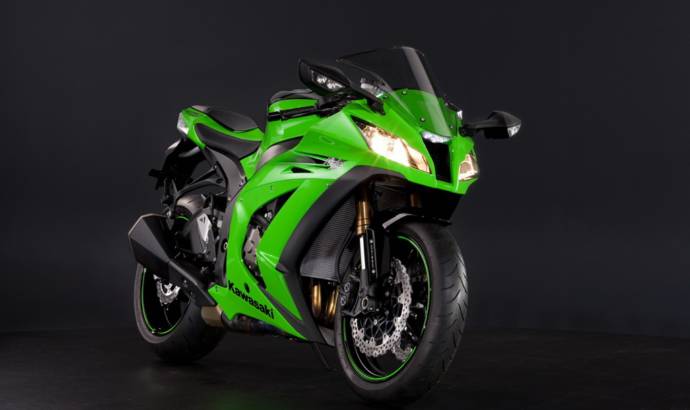
06 Oct 2010
0

